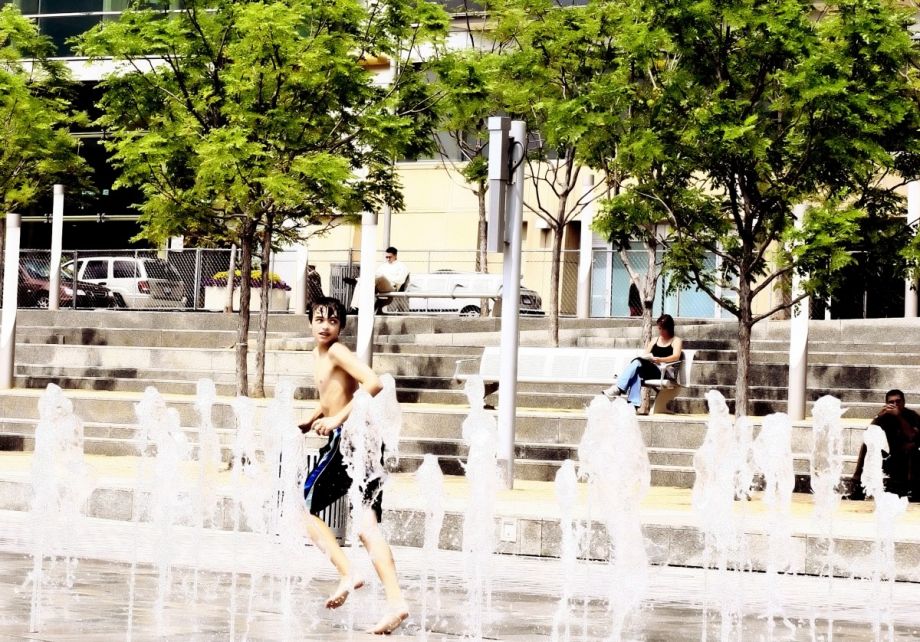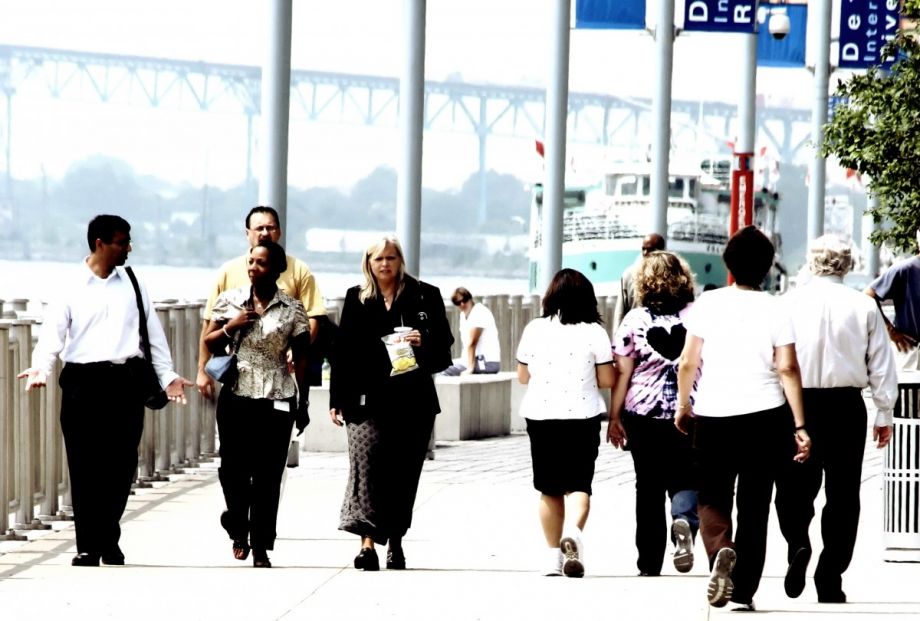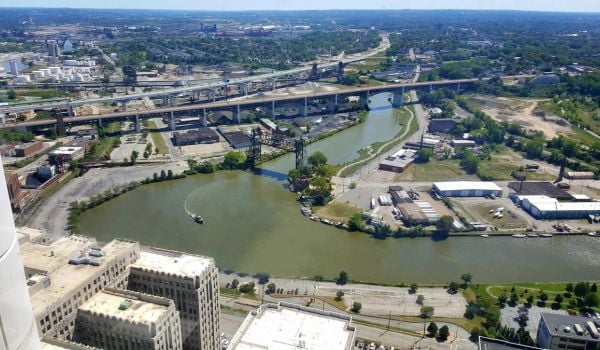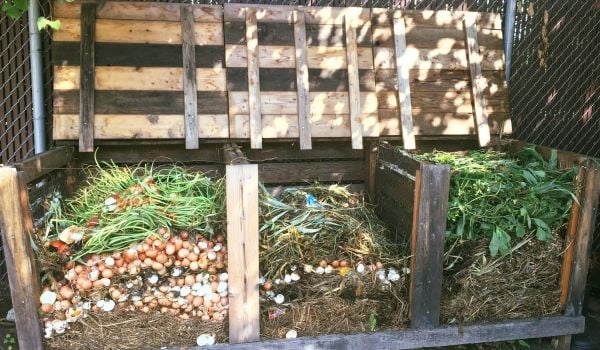On an unusually warm day in late March, Angelo Johnson, and her daughter and grandchildren piled into her car and headed to the Detroit riverfront to enjoy the afternoon. It was sunny and lots of people were walking and exercising, or just taking in the beauty of the park that stretches three and a half miles along the waterway.
While some have been critical of the lack of progress on major downtown revitalization projects, Johnson, a lifelong Detroiter, sees hope along the river. “I just felt like, oh my, this is awesome,” she says. “Look how the city is growing up and look at all the people enjoying it. It’s fascinating to me because it’s not something I’ve seen before.”
The riverfront may be one of the most diverse places in southeast Michigan, with visitors of all races and income levels. On any given day you can spot athletes, families on bikes, women wearing saris and hijabs, businessmen in suits, and children playing. The public space is a multicultural mecca within a city that’s still one of the most segregated in America. And while the past decade has seen about $1 billion in investment there and the city anticipates doubling that in the next 10 years, officials are also mindful of maintaining that welcoming atmosphere.
According to a January Detroit Free Press report on plans to continue developing another 400 underutilized acres, “leaders want to avoid making the east riverfront a gated enclave for the wealthy. Instead they insist that the east riverfront become an ‘inclusive’ district that includes significant affordable housing and that ‘looks like Detroit.’”
John Marshall, onetime CEO of the Kresge Foundation, a philanthropic organization based in Troy, Michigan, says the riverfront park “rivals the Emerald Necklace in Boston the High Line in New York City and waterfront access in the Bay Area.”
He’s right. And Johnson sees that beauty too, and how the riverfront makes people feel. “Everyone just seemed happy,” she says. She should know. The 75-year-old has experienced many of Detroit’s most significant moments both good and bad — from the rise of Motown Records to the ’67 uprising to the Detroit Tigers winning the ’84 World Series. But free access to parks and waterways is something the 75-year-old Johnson hasn’t experienced much.
Michigan is home to 285,000 acres of lush state parks and lakes, but if you were without transportation in the ’80s and ’90s, the state’s parklands were out of reach. And while Detroit’s riverfront is a main artery of the city’s geography and stretches from the western edge to the farthest eastern part of the city, until the early 2000s, it was a wasteland of empty, burned-out warehouses, cement silos, neglected roads and parking lots.
“Even though I lived here, I didn’t go down there,” says Johnson, who has lived roughly one mile from the Detroit River for more than 50 years.
The Detroit River was central to city’s birth. Water opened the region to trade. It powered the rise of Detroit’s mighty industries such as timber, paper and auto, and served as the conduit for shipping goods and raw materials.
And water defines the state. Michigan is surrounded by four of the five Great Lakes, cradled by 20 percent of world’s surface freshwater. It is dotted with 11,000 inland lakes and thousands of miles of rivers, streams and wetlands, and you simply can’t travel more than six miles in the state without hitting water.
That’s all great, but what does it say about a city and its leadership when some of its own residents couldn’t enjoy its greatest natural asset? And the deteriorating riverfront wasn’t just missing a natural asset opportunity. There’s sacred meaning in the river to Detroit’s large African-American population. According to the Detroit Historical Society, between the 1820s and 1865, Detroit, with its “radicalized black community and abolitionist sympathizers” had become the doorway to freedom for thousands of slaves. The city provided access to Canada across the Detroit River.
Yet as Detroit’s fortunes were proclaimed and derided amid white flight, loss of manufacturing jobs and deep-seated structural racism, the city ignored the riverfront in terms of natural public space.
“Historically, the narrative was that the river was industrial,” says Sheila M. Cockrel, former city council member and co-founder of Citizen Detroit, a community engagement initiative. “The thinking at the time was to keep people in the buildings, not out.”
In 1977, The Renaissance Center, which is now the world headquarters for General Motors, was built on the riverfront as gargantuan symbol of Detroit’s rebirth. The building, a self-contained collection of silver and blue-tinted skyscrapers, is still an impressive and dominant part of the Detroit’s landscape.
“[It sat] on the river’s edge like a fortress,” says Matt Cullen, the former general manager of economic development for General Motors. “You couldn’t walk from the building to the water.” Instead of beautifying its access point to the water, Renaissance Center Developers built an ugly parking lot next to the river.
In the 1970s, Detroit’s then-Mayor Coleman Young oversaw the creation of downtown’s Hart Plaza, a popular site near the water for concerts, ethnic festivals and public gatherings. It can hold 40,000 people. Young understood the significance of giving people access to the Detroit River and he tried to build on the city’s rich assets.
“Detroit had always been able to draw people to big events like the fireworks with Canada, sporting events, going to the symphony and the Fisher Theater,” says Marshall. But those single-night events were only “for a specific purpose,” and did little to change the face of the city.
In the late 1990s, the Michigan gaming industry lobbied hard to win contracts to build three casinos in Detroit right next to the water. Then in 2001, the city announced that it would not sell riverfront land off for gambling. Instead, it negotiated development agreements for permanent casinos to be built away from the river.
After the casino ventures fell through, civic, corporate and philanthropic leaders came together to transform the riverfront into breathtaking public spaces built on concepts of public good and regional health. GM, for one, owned half a mile of property on the water and wanted to do something that would have a lasting impact for city residents.
Still there were questions. How were the players who were involved in this riverfront redevelopment going to deal with race and segregation in Detroit? If Detroit failed its citizens with this project, it might’ve enshrined the emerging reality of two societies — one black, one white — separate and unequal.
“There are big issues to deal with from a racial equity perspective,” says Andrea Brown, executive director of the Michigan Association of Planning. “As planners we have to ask, how are people getting to the riverfront and what are we doing in terms of education?”
Such questions initiated an intense and deliberate public participation process by Smith Group JJR, designers of the riverfront. The designers held 150 community forums, went to churches and schools, and asked the community what they thought the riverfront should be.
“The residents told us that they didn’t want to lose their culture. They wanted us to respect the current community,” says Pat Doher, senior vice president at Smith Group JJR. “The design of one of the promenades is based on African cloths. That is an idea that came out of the meetings.”
Detroit had ribbon farms in its early days of trade. Long, narrow strips of land, lined up along the river. “We planted a row of pear trees that is indicative of the ribbon farms,” Doher says. “We deliberately made connections to Detroit’s history.”
And while incorporating historical and design elements was critical, Detroit’s African-American and Latino community wanted the development to be a place for family life.
“We wanted safety, security and lighting and inviting green areas that could be used without a car,” says Maria Elena Rodriguez, former President of Mexicantown Community Development Association.
The Detroit riverfront development has made tremendous strides in attracting a diverse community, but Detroit families still face obstacles in getting their children to kid-friendly places. Roughly one-third of the city’s population is under the age of 18.
“One of the biggest challenges facing the riverwalk development is mass transit for the poor,” says Sarida Scott, executive director of Community Development Advocates of Detroit.
As the mother of a 9-year-old, Scott says she’s committed to raising an “urban child” and the Detroit RiverWalk fits in her plan. “I purposely did not move to the suburbs. I wanted my daughter to enjoy what city living has to offer,” says Scott. “We’ve been kite flying and fishing there.

Three million visitors come annually to walk or exercise or spend time with family on the completed portions of Detroit's waterfront.
The Detroit Riverfront Conservancy, the nonprofit that oversees operations of the Detroit RiverWalk, has implemented programming to attract families. “Reading & Rhythm” is an early literacy program now in its sixth year. “People are always looking for family programming, and ‘free’ is definitely a way to get people to participate,” Scott says. “I have one child, everything costs.”
The current riverfront development spans more than three miles. By the time the expansion is complete it will be five and a half miles of revitalized riverfront — one of the longest in the U.S. Now 3 million visitors come annually to walk or exercise or spend time with family on the completed portions of the river and greenways. There are plazas, fountains, areas for lounging, lush gardens and even a carousel.
Health and wellness are synonymous with the river’s banks now. “We’ve been teaching yoga on the riverfront for 10 years now,” says Michelle Moten, owner of Urban Solace Yoga and Wellness. “It was a way to encourage people to come and create a sense of community to really celebrate our waterfront but also to promote a healthy lifestyle. We’ve been an industrial town for years and we had our backs to the waterfront so it’s a nice opportunity to not only to exercise outdoors but also to celebrate the jewel that is our city that’s off the water.”
Industrial wasteland became the region’s own beautiful backyard, for anyone to use. “It’s owned by everyone,” Cockrel says, “from the homeless to the wealthiest Detroiters, there is a space for everyone on that riverfront.”
The riverfront project is far from finished: The Detroit Riverfront Conservancy recently announced that Mohsen Mostafavi, dean of the Harvard University Graduate School of Design, will lead a “Creative Detroit Think Tank,” and internationally renowned landscape architect, Michel Desvigne, recognized for his contemporary expertise in the design and construction of gardens and public spaces, will participate in planning for future development along the East Riverfront District.
As for Angelo Johnson, she says she loves just being able to see the water: “Poor people used to go down and fish. Now there are all kinds of people, all kinds of restaurants. The walkway is for everyone. Now my granddaughters go there and walk for hours and hours.”
Martina Guzmán is an award-winning reporter and nationally recognized journalist who writes about marginalized communities through the lens of race, poverty and culture. She is the proud daughter of Mexican immigrants and a graduate of Columbia University's journalism school.





_600_350_80_s_c1.JPEG)










